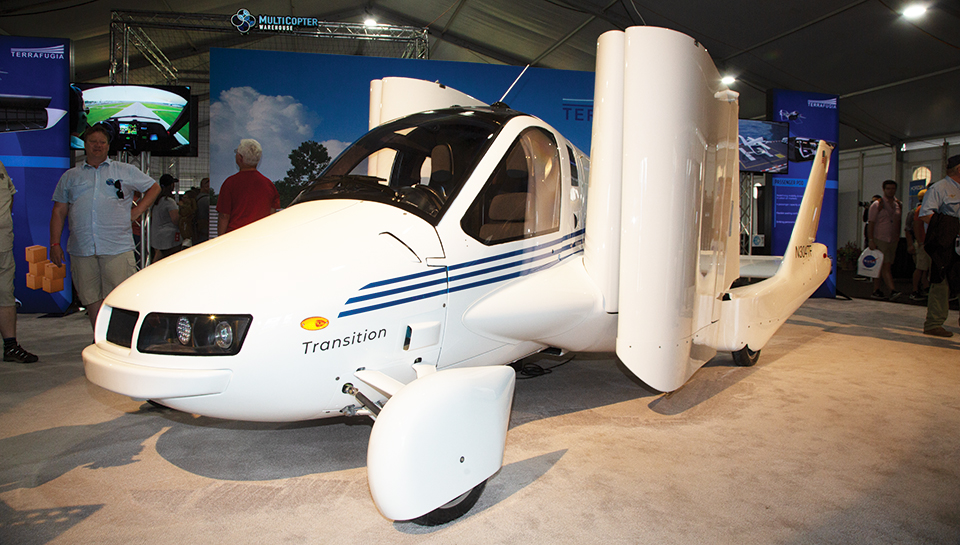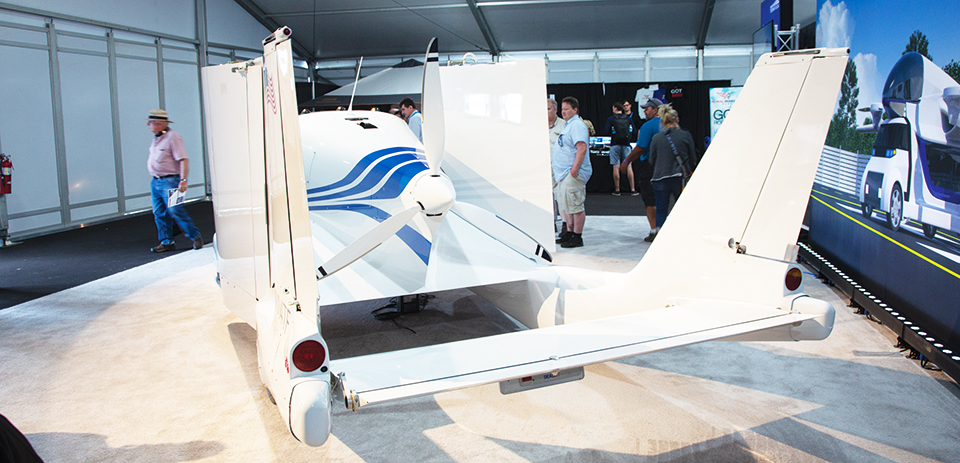Terrafugia Upgrades Its Flying Car
Company says Transition on track for first customer delivery in 2019
By James Wynbrandt
July 27, 2018 - Flying car developer Terrafugia has announced major design enhancements for the Transition, its in-development, two-place flying car, and also introduced its next transportation concept, a VTOL aircraft for passenger and cargo transport. Terrafugia (UAV Showcase, Booth D17) is also exhibiting D2, the prototype vehicle that flew at EAA AirVenture Oshkosh five years ago, and now has 200 flight hours under its belt. D2 will be replaced in the certification program by the forthcoming Flight Assessment Vehicle, which will incorporate the enhancements announced at the fly-in.
Among the upgrades: in drive mode, Transition will be a hybrid vehicle, powered by a combination of an internal combustion engine and a LiFePO4 (lithium iron phosphate chemistry) battery — a safer technology than other lithium battery chemistries, according to the company. In flight mode, a boost feature will be added to the throttle for brief boosts of extra power. The improved interior will sport upgraded seats, a new intuitive user interface, and increased luggage capacity. Overall safety improvements include upgrades to seat belts and air bags, and enhanced visibility in drive mode with three rearview cameras.
Dynon will provide the electronic flight instrument system for its flight mode, and BRS will provide a full frame parachute system.
One thing that hasn’t changed is the company’s ambitious plans for Transition’s commercial launch. “We are aiming to have this aircraft certified and make our first customer delivery in 2019,” a company spokesperson said.
In flight, Transition will be powered by a 100-hp Rotax 912iS engine, and by hybrid-electric powered motors for driving. The vehicle’s projected takeoff distance is 1,400 feet, useful load is 500 pounds, maximum speed is 100 mph, and max range is 400 miles.
Terrafugia is showcasing the vehicle’s folding wings — they collapse for drive mode and unfold for flying — with demonstrations on the hour throughout the show.
In addition to meeting FAA certification requirements, the Transition will meet National Highway Traffic Safety Administration (NHTSA) standards. No price for the vehicle has been announced. “We understand the market we’re in, and we have to be competitively priced with light-sport and general aviation aircraft,” the spokesperson said. The company is now taking deposits for delivery positions and more information on the deposit program is available through its website.
Terrafugia also unveiled TF-2, an integrated system designed for urban air transportation applications. TF-2 consists of a hybrid electric VTOL aircraft; a ground transportation vehicle; and a passenger/cargo pod that can be transported by the ground vehicle or slung under the VTOL. For transportation applications, the concept calls for the ground vehicle carrying a passenger pod to pick up the passengers and transport them in the pod to a vertiport, attach the pod to the VTOL that will carry them by air to another vertiport, then transport the pod by ground vehicle the last mile to their final destination. Designed for four passengers, maximum speed is projected at 120-130 knots and the anticipated range is 170-215 nm.
“We’ve talked about the goal of having a flying vehicle by 2023,” said the spokesperson. “What we’re learning with Transition will feed our knowledge and experience on how to take that next step forward.”
Terrafugia is a subsidiary of China’s Zhejiang Geely Holding Group, which owns Volvo, Lotus, and other international auto brands.

